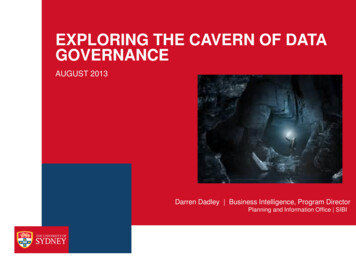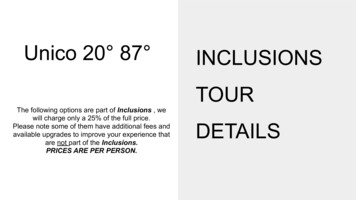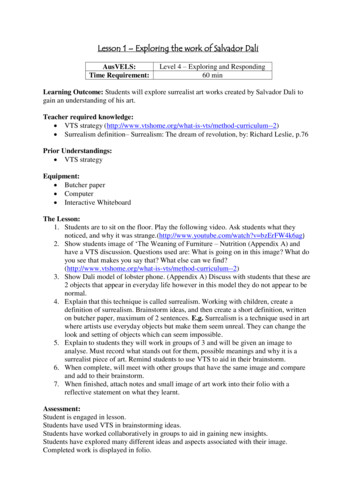
Transcription
EXPLORING THE CAVERN OF DATAGOVERNANCEAUGUST 2013Darren Dadley Business Intelligence, Program DirectorPlanning and Information Office SIBI
Data Management OverviewSIBI Program Methodology2
Definitions: Data Management & Data GovernanceData ManagementThe planning, execution and oversight of policies, practicesand projects that acquire, control, protect, deliver, andenhance the value of data and information assets. (*)Data GovernanceThe exercise of authority and control (planning,monitoring, and enforcement) over the management ofdata assets. (*)(*)DAMA International 20093
Data Governance OverviewData Governance Challenges – Key reasons for Failure (*)---Assign sponsorDG ForumsPersonaldevelopmentplansKPIsEducationBest practicesBench markingLeverage othersuccessesLack ofOwnershipOwnership, responsibilityand accountability notassigned.Lack ofAwarenessExecutives and keystakeholders of datamanagementcapabilities have a lackof knowledge andawareness of DG.Failure toExecuteLack of knowledge andUnderstanding by SeniorManagement (i.e. skillsrequirements, strategicoutcomes, processimprovement) leads to afailure to execute.-DataGovernanceChallenges-RACIData stewardsPersonaldevelopment plansKPIsLack ofAccountabilityAccountability notassigned to eachprocessTask isoverwhelmingDG is too big for anyone person toaccomplish.Adequate resourcesare not assigned.--Pilot projectsSeries ofmanageableprojectsIdentify key areasof concernSplit the tasksIdentify and shops(*)Adapted from 2011 Baseline Consulting Group, Inc.4
Data Governance StrategyWhat is DataGovernancefor theUniversity Develop DGvision statement inline withUniversity’sstrategic vision Define DG Scope DG withcontext ofUniversityIdentify akey initiativeas a PilotDevelopprocesses Define KPIsas measuresfor successEducate andengagestakeholders Define DataGovernanceFrameworkDefine DGorganisationDefine roles andresponsibilities(RACI) Select DataManagementPilot areaWorkshop toidentify anddevelop KPIs Determineaccountabilityfor KPIs Identify KPIbenefits andROI Define PilotgroupDocumentimprovementsand processes Develop trainingplan Developcommunicationsand engagementplan Educatestakeholdersabout DGReview anddefine processmaps Establish SOPs(standardoperatingprocedures) Develop reviewprocessCommunicatesuccess SUCCESSFULDATAGOVERNANCECommunicatesuccess to keystakeholders andbroader audience(email, bulletin,newsletters)Managing Expectations5
Data Governance vs. Data ManagementData ManagementData Governance(Execution)(Organisation and Activities)Data profilingStrategyOrganisation and roles Provide Guidance Create & ImplementDeliverablesData quality monitoringData cleansingSemantic rulesDeliverables and standardsData enrichmentBusiness rules creation &maintenanceProjects and servicesIssues managementCreating guiding principles Provide Feedback Track ProgressEnterprise data modelingMetadata definitionBusiness glossary definitionData archivalData asset valuationBackup and RecoveryAuthentication6
Data Management Overview(DMBOK) Data Management Functions Analysis Measurement Improvement Architecture Integration Control Delivery Acquisition & Storage Backup & Recovery Content Management Retrieval Retention Architecture Implementation Training & Support Monitoring and Tuning Enterprise Data Modelling Value Chain AnalysisData elopmentMeta DataManagementDocument &ContentManagementDataGovernanceDataWarehousing &BusinessIntelligenceManagementReference &Master DataManagementDatabaseOperationsManagementData SecurityManagement Data Modelling Database Design SDLC Implementation Acquisition Recovery Tuning Retention Purging Standards Classification Administration Authentication Auditing External Codes & Internal Codes Customer Data Product Data Dimension Management7
Data Management OverviewCurrent focus for SIBI› Data Governance› Data Security Management – Data Visibility› Data Quality and Data Profiling› Master Data Management› Metadata Management & Business GlossaryUniversity ofSydneyDataManagementDataGovernanceSIBI8
Data Management OverviewDMBOK – 7 Environmental Elements TechnologyProcess Goals & PrinciplesActivitiesDeliverablesPractices & TechniquesProvide a consistent way to describe and strategically plan each functionOrganisation &CultureGoals & PrinciplesRoles &ResponsibilitiesPractices &TechniquesTechnologyOrganisation & CultureRoles & ResponsibilitiesActivities DeliverablesPeopleUniversity of Sydney Data Management FrameworkStrategyTechnology9
Data Management OverviewDMBOK – 7 Environmental Elements› Goals & Principles – The directional business goals of each function and the fundamental principles that guide performanceof each function.› Activities - Each function is further decomposed into lower level activities (tasks and steps)› Deliverables - The information and physical databases and documents created as interim and final outputs of each function.Some are considered essential, some are generally recommended, and others are optional depending on circumstances.› Roles and Responsibilities - The business and IT roles involved in performing and supervising the function and the specificresponsibilities of each role in that function. Many roles will participate in multiple functions.› Practices & Procedures - Common and popular methods and techniques used to perform the processes and produce thedeliverables. Risks and issues management.› Technology - Categories of supporting technology (primarily software tools), standards and protocols, product selectioncriteria and common learning curves.› Organisation and Culture - These issues might include:- Reporting Structures, Teamwork and Group Dynamics- Budgeting and Related Resource Allocation Issues- Authority & Empowerment- Shared Values, Beliefs, Expectations & Attitudes- Change Management Recommendations- User engagement: communications / training / education10
Data Governance OverviewData Governance – University Organisation & CultureOrganisation Own the data governance strategy Promote, endorse and approve thedevelopment and enhancement of thedata governance management frameworkDeans of Faculties and Directors ofProfessional services Units, e.g.Finance, Research, HR, ICTData Governance Committee(DGC)Directors, Heads of department,Managers of functional areas Data Owners ManagementGroup (DOMG) Support the DGC, by implementing andrefining the data ownership, datastewardship and data custodian rolesthroughout the University. Provide Subject Matter Expert (SME)knowledge and support to the datagovernance strategyData ModellersInformation / DataArchitectOperating modelArbiters & escalations pointsData Governance organisation membersRoles & ResponsibilitiesTerms of ReferenceData ownership and responsibilitySupported by:Data IntegrationSpecialistsDatabaseAdministratorsData StewardsData QualitySpecialists11
Data Management OverviewUniversity Principles and Goals inciplesManagedSharedRe-usedTrusted. We trust in our information. Access to and use of datawill promote trust and confidence through adherence to relevantData Governance Policies and procedures, privacy, confidentialityand security requirements.Valued. Data is valued as a strategic resource and an asset. As aresult, data and information will be of high quality, accurate,relevant, timely and support confident business decisions.Shared. Information and data is accessible, transparent andavailable to be shared as part of the University’s sharing ofinformation obligations to; the community, staff, students,researchers and alumni.Re-Used. Data and information should be obtained from a singleauthoritative source. Data and information is collected in aconsistent manner and is available to be used for differentpurposes with confidence.Managed. Data and information is managed throughout itslifecycle and is compliant. Information Management Proceduresand practices are standardised and applied across the Universityand apply to all involved in the data management lifecycle.Governed. Data and information is governed in accordance withthe roles and responsibilities as defined in the University’s DataGovernance Framework, the University’s strategic goals and incompliance with the requirements of Law.12
Data Management OverviewDeliverables, Activities, Practices & Techniques13
Data Management OverviewDMBOK Functions Analysis Measurement Improvement Architecture Integration Control Delivery Acquisition & Storage Backup & Recovery Content Management Retrieval Retention Architecture Implementation Training & Support Monitoring and Tuning Enterprise Data Modelling Value Chain AnalysisData elopmentMeta DataManagementDocument &ContentManagement Data Modelling Database Design SDLC ImplementationDataGovernanceDataWarehousing &BusinessIntelligenceManagementReference &Master DataManagementDatabaseOperationsManagementData SecurityManagement Acquisition Recovery Tuning Retention Purging Standards Classification Administration Authentication Auditing External Codes & Internal Codes Customer Data Product Data Dimension Management14
Data Quality ManagementDefinitionPlanning, implementation and control activities that apply qualitymanagement techniques to measure, assess, improve and ensure thefitness of data for use.**Source: DAMA-MBOK 200915
Universityof SydneyData Quality Management Framework – HR PilotVisionOrganisation & Culture*** Develop vision for DataQuality Mgmt. and for Pilotwith HR data. (workshop)ChangeManagementGoalsRisk MatrixDeliverablesIssues LogAccuracyActivitiesPilot groupstructureAuthority &EmpowermentCritical successfactorsExpectations &CommunicationAttitudesInformationComplianceData ser EngagementEducationCommsCompletenessRoles and ResponsibilitiesPrinciplesPractices &TechniquesConsistencyIntegrityRolesData StewardData OwnerForumsSponsorSIBI ogy: Data Profiling (Informatica), Data cleansing (IDQ-Informatica)BOG
Data Quality ManagementData Quality TimelinessValidity Does the data accurately represent reality or a verifiablesource? Is all necessary data present? Are all data elements consistently defined andunderstood? Is the structure of data and relationships among entitiesand attributes maintained consistently? Is data available when needed? Do data values fall within acceptable ranges defined bythe business?17
Data Quality Methodology - RoadmapIDE – InformaticaData Profiling toolTechnology1. PromoteDQAwarenessActivitiesEnables data profiling andanalysis with the flexibilityto filter and drill down onspecific records for betterdetection of problems.Identifyknown dataissues2. Define DQRequirementsExtract &providedataIDQ – InformaticaData Quality tool6. Test &validate DQRequirem.3. Profile,Analyse &Assess DQ4/5.DefineDQ metrics &Business rulesVisionstatement10. Clean &correct DQdefects7. Set &evaluate DQservice levelsEnables architects anddevelopers to discoverand access all datasources, to improve theprocess of analyzing,profiling, validating, andcleansing data.11. Design andimplement DQMprocedures(SOPs)RecommendActionsBaselineData filesDeliverablesDQMFrameworkScorecardReportData IssueLogUpdatedIssue LogRACIControlActivities8. Continuously measure and monitorDQActivities for DQ Pilot9. Manage DQ issuesActivities for DQ methodologyActions:- Training / education / comms- Business ProcessesImprovement (SOPs)- Data Validation (data entryprocess)12. Monitor operational DQMprocedures and performance18
Data Management OverviewNext Steps19
Data Governance Overview 11 Data Governance - University Organisation & Culture Support the DGC, by implementing and refining the data ownership, data stewardship and data custodian roles throughout the University. Provide Subject Matter Expert (SME) knowledge and support to the data governance strategy Own the data governance .










